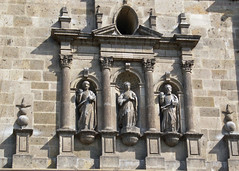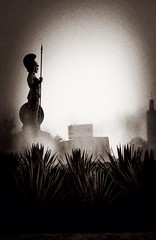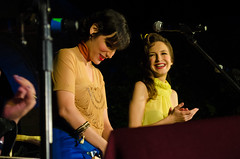Guadalajara
Guadalajara (English: /ˌɡwdəˈhə/ , Spanish: [ɡwaðalaˈxaɾa]) is a metropolis in western Mexico and the capital of the state of Jalisco. According to the 2020 census, the city has a population of 1,385,629 people, making it the 7th most populous city in Mexico, while the Guadalajara metropolitan area has a population of 5,268,642 people, making it the third-largest metropolitan area in the country and the twentieth largest metropolitan area in the Americas Guadalajara has the second-highest population density in Mexico, with over 10,361 people per square kilometer. Within Mexico, Guadalajara is a center of business, arts and culture, technology and tourism; as well as the economic center of the Bajío region. It usually ranks among the 100 most productive and globally competitive cities in the world. It is home to numerous landmarks, including Guadalajara Cathedral, the Teatro Degollado, the Templo Expiatorio, the UNESCO World Heritage site Hospicio Cabañas, and the San Juan de Dios Market—the largest indoor market in Latin America.
A settlement was established in the region of Guadalajara in early 1532 by Cristóbal de Oñate, a Basque conquistador in the expedition of Nuño Beltrán de Guzmán. The settlement was renamed and moved several times before assuming the name Guadalajara after the birthplace of Guzmán and in 1542, ending up at its current location in the Atemajac Valley. On November 8, 1539 the Emperor Charles V had granted a coat of arms and the title of city to the new town and established it as the capital of the Kingdom of Nueva Galicia, part of the Viceroyalty of New Spain. After 1572, the Royal Audiencia of Guadalajara, previously subordinate to Mexico City, became the only authority in New Spain with autonomy over Nueva Galicia, owing to rapidly growing wealth in the kingdom following the discovery of silver. By the 18th century, Guadalajara had taken its place as Mexico's second largest city, following mass colonial migrations in the 1720s and 1760s. During the Mexican War of Independence, independence leader Miguel Hidalgo y Costilla established Mexico's first revolutionary government in Guadalajara in 1810. The city flourished during the Porfiriato, with the advent of the industrial revolution, but its growth was hampered significantly during the Mexican Revolution. In 1929, the Cristero War ended within the confines of the city, when President Plutarco Elías Calles proclaimed the Grito de Guadalajara. The city saw continuous growth throughout the rest of the 20th century, attaining a metro population of 1 million in the 1960s and surpassing 3 million in the 1990s.
Guadalajara is a Gamma+ global city, and one of Mexico's most important cultural centers. It is home to numerous mainstays of Mexican culture, including Mariachi, Tequila, and Birria and hosts numerous notable events, including the Guadalajara International Film Festival, one of the most important film festival in Latin America, and the Guadalajara International Book Fair, the largest book fair in the Americas. The city was the American Capital of Culture in 2005 and has hosted numerous global events, including the 1970 FIFA World Cup, the 1986 FIFA World Cup, the 1st Ibero-American Summit in 1991, and the 2011 Pan American Games. The city is home to numerous universities and research institutions, including the University of Guadalajara and the Universidad Autónoma de Guadalajara, two of the highest-ranked universities in Mexico.
Etymology
The conquistador named the city in honor of the conqueror of western Mexico, , who was born in , Spain. The name comes from the Arabic , which means 'Valley of the Stone', or 'Fortress Valley'.
History
Pre-Hispanic era
Unlike the surrounding areas, the central Atemajac Valley, where Guadalajara is located, contained no human settlements. To the east of the Atemajac Valley were the Tonallan and Tetlán peoples. At the extremes were the Zapopan, Atemajac, Zoquipan, Tesistan, Coyula, and Huentitán.
The historic city center encompasses what was once four population centers, as the villages of the Mezquitán, Analco, and Mexicaltzingo were annexed to the Atemajac site in 1669.
Foundation
Guadalajara was originally founded at three other sites before moving to its current location. The first colonial settlement in 1532 was in Mesa del Cerro, now known as Nochistlán, Zacatecas. This site was colonized by Cristóbal de Oñate as commissioned by Nuño de Guzmán, with the purpose of securing recent conquests and "defending" them from the "still-hostile natives". This colonized settlement did not last long due to its lack of usable water sources. In 1533 it was moved to a site near Tonalá. Four years later, Guzmán ordered that the village be moved to Tlacotán. During this time, the Spanish king Charles I granted the city the coat of arms which it retains to this day.
During the Mixtón War, the Caxcan, Portecuex, and Zacateco peoples, fought back against colonizers under the command of Tenamaxtli. The war was initiated in response to the heinous treatment of indigenous peoples by Nuño de Guzmán, in particular the enslavement of captured natives. After multiple defeats, Viceroy Antonio de Mendoza took control of the Spanish campaign to suppress the revolt. The conflict ended after Mendoza made concessions such as freeing enslaved indigenous peoples and granting amnesty. The village of Guadalajara barely survived the war, and the villagers attributed their survival to the Archangel Michael, who remains the patron of the city to this day.
After the war, the city was moved once again—this time to a more defensible location. This final relocation would prove permanent. In 1542, records indicate that 126 people were living in Guadalajara. That same year, it was granted cityhood by the king of Spain. Guadalajara was officially founded on February 14, 1542, in the Atemajac Valley. The colonized settlement was named for Nuño de Guzmán's Spanish hometown.
In 1559, royal and bishopric offices for the province of Nueva Galicia were moved from Compostela to Guadalajara and, in 1560, Guadalajara became the province's new capital. Construction of the cathedral began in 1563. In 1575, religious orders such as the Augustinians and Dominicans arrived, eventually making the city a center for evangelization efforts.
While capital of the Kingdom of Nueva Galicia, the city's inhabitants achieved a high standard of living, due to flourishing industry, agriculture, commerce, mining, and trade. The Guadalajara of the sixteenth century was a rather small and often overlooked community. It was mainly frequented by traveling merchants. Several epidemics drastically reduced the city's indigenous population, leading to the construction of its first hospital in 1557.
Guadalajara's economy during the 18th century was based on agriculture and the production of non-durable goods such as textiles, shoes and food products.
Despite epidemics, plagues, and earthquakes, Guadalajara would become one of the most important population centers in New Spain. The city's heyday attracted numerous architects, philosophers, lawyers, scientists, poets, writers, and speakers; Francisco Xavier Clavijero and Matías de la Mota Padilla were among the most prominent. In 1771, Bishop Fray Antonio Alcalde arrived in the city and founded the Civil Hospital and the University of Guadalajara. In 1791, the University of Guadalajara was established. The dedication was held in 1792 at the site of the old Santo Tomas College. While the institution was founded during the 18th century, it would not be fully developed until the 20th century, starting in 1925. In 1794, the Hospital Real de San Miguel de Belén, or simply the Hospital de Belén, was opened.
In 1793, Mariano Valdés Téllez ran the city's first printing press, whose first publication was a funeral eulogy for Fray Antonio Alcalde.
Independence
Guadalajara remained the capital of Nueva Galicia with some modifications until the Mexican War of Independence. Miguel Hidalgo entered San Pedro (now Tlaquepaque) on November 25, 1810, and the next day he was greeted effusively in Guadalajara. The city's workers had experienced poor living conditions and were swayed by promises of lower taxes and the abolition of slavery. Despite a soured welcome, due to the rebel army's violence toward city residents, especially royalists, Hidalgo kept his promise and, on December 6, 1810, slavery was abolished in Guadalajara, a proclamation which has been honored since the end of the war. During this time, he founded the newspaper El Despertador Americano, dedicated to the insurgent cause.
Royalist forces marched to Guadalajara, arriving in January 1811 with nearly 6,000 men. Insurgents Ignacio Allende and Mariano Abasolo wanted to concentrate their forces in the city and plan an escape route should they be defeated, but Hidalgo rejected this idea. Their second choice was to make a stand at the Puente de Calderon just outside the city. Hidalgo had between 80,000 and 100,000 men and 95 cannons, but the better-trained royalists won, decimating the insurgent army and forcing Hidalgo to flee toward Aguascalientes. Guadalajara remained in royalist hands until near the end of the war.'
On January 17, 1817, the insurgent army was again defeated on the outskirts of Guadalajara in the Battle of Calderón Bridge. New Galicia, now Jalisco, adhered to the Plan de Iguala on June 13, 1821.
In 1823, Guadalajara became the capital of the newly founded state of Jalisco. In 1844, General Mariano Paredes y Arrillaga initiated a revolt against the government of President Antonio López de Santa Anna. Santa Anna personally ensured that the revolt was quelled. However, while Santa Anna was in Guadalajara, a revolt called the Three Hour Revolution brought José Joaquín Herrera to the presidency and put Santa Anna into exile.
President Benito Juárez made Guadalajara the seat of his government in 1856, during the Reform War. French troops entered the city during the French Inte…
Looking for places related to Guadalajara?
Those are other destinations to find places related to Guadalajara:




















